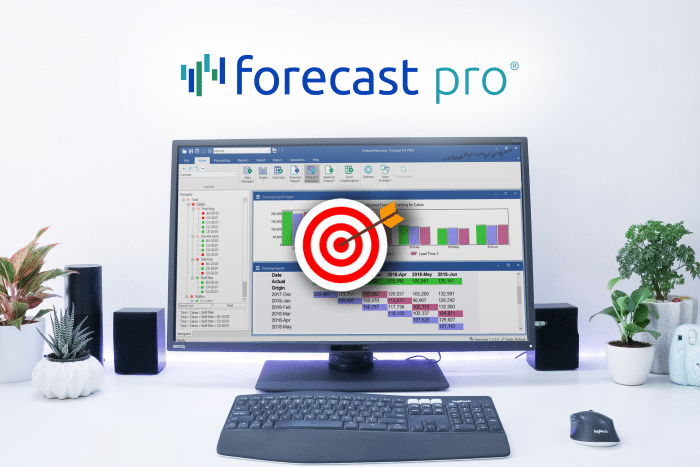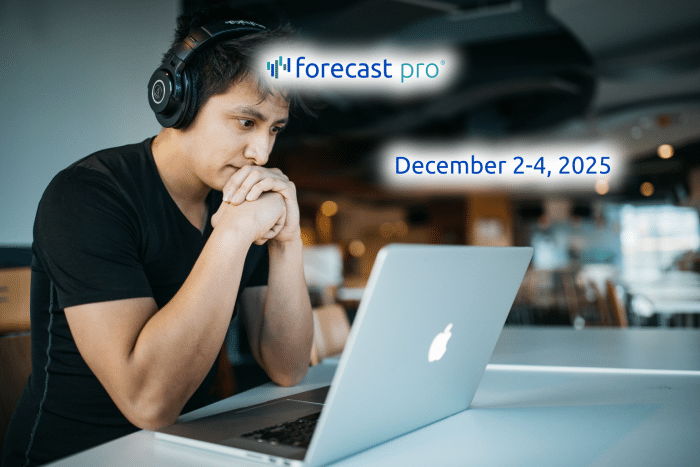Latest News and Posts
Keep your forecasting skills sharp by checking out the articles below.
Upcoming Events
Creating Accurate Forecasts When Your Demand History Includes Outliers
Preparing forecasts using data that contain one or more unusually large or small demand periods can be challenging. Depending on your forecasting approach, these “outliers” can have a significant impact on your forecasts. This article surveys three different approaches to forecasting data containing unusual demand periods, discusses the pros and cons of each and recommends when it is best to [...]
The Ins and Outs of Using Dynamic Regression Models for Forecasting
The recording of our recent educational one-hour Webinar is now available for viewing on-demand https://youtu.be/XBYqjV6imS0 This session demystifies regression modeling, demonstrating how these models can provide insight into your data and why they often yield more accurate results than alternative forecasting methods. Learn: When to apply regression models How to build and diagnose the models How to use leading indicators, [...]
Managing Forecasts by Exception
Human review of a statistically-generated forecast is an important step in the forecast process. Ideally, every statistical forecast should be inspected for plausibility. At times, the sheer volume of the forecasts being generated precludes exhaustive individual inspection. In these instances, exception reports are an effective tool to help you sift through the forecasts and focus on the items where human [...]
Forecasting Products with Little or No Demand History
Demand history can provide forecasters with key insights into current trends, seasonal patterns and the relationships between demand and explanatory variables. Thus, creating forecasts when little or no demand history is available is particularly challenging. In this installment of Forecasting 101 we’ll examine different approaches to creating forecasts when little or no demand history is available. […]
When is a Flat-line Appropriate and What Does it Tell You About Your Demand?
A forecasting technique which generates a forecast based solely on an item’s past demand history is referred to as a time series method. Typically, time series methods will capture structure in the history—such as current sales levels, trends and seasonal patterns—and extrapolate them forward. When the data are not trended and are not seasonal, a time series method will often generate [...]
Selecting Your Statistical Forecasting Level: How Low Should You Go?
Many organizations need to generate forecasts at very detailed levels. For example, a consumer products company may need an SKU-by-customer forecast, a shoe manufacturer may need a shoe-by-size forecast, or an automobile manufacturer may need a parts-level forecast. One approach to generating low-level forecasts is to apply statistical forecasting methods directly to the lowest-level demand histories. An alternative approach is [...]
Event Models & Using the New Event Manager in Forecast Pro
Forecast Pro’s Expert Selection system can generate thousands of forecasts automatically; however, the automatic forecasting approach can fall short if the historical data do not represent a typical demand pattern for a given item because of certain events. For example, an unexpected large order may inflate the forecast for the following year, or a stockout may skew the forecast in [...]
Identifying Problems in Your Data & Forecasts
The recording of our recent educational one-hour Webinar is now available for viewing on-demand http://www.youtube.com/watch?v=k2yt5Cd7fOo Learn about helpful tools that make it easier for you to focus on the specific items that need your attention: Outlier detection for highlighting anomalies in historic data. Exception reports for identifying problems in the forecasts. Item reports for quickly defining and reviewing subsets of your [...]
How to Improve Your Forecasts Using Events
Watch the recording of our educational one-hour Webinar. http://youtu.be/coeFfecxNw8 You will learn: How event models work How and when event models should be used How to build customized event variables to meet your needs Best practices for applying event models





